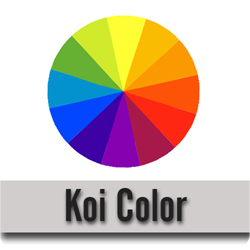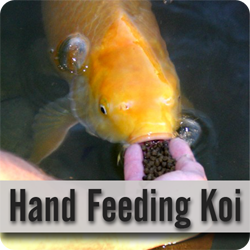Understanding Koi food production
Most fish foods today are extruded, which means the ingredients are mixed into a batter, cut to size, and then quickly cooked under pressure.
Once the assembling, blending, and grinding of raw ingredients is complete they are hammered into a fine meal of appropriate consistency. At this stage the mixture is tested and verified to be compliant with the feed formulation and plant specifications, then cleared for extrusion.
For optimum digestibility the feeds are subjected to thermal processing where anti-nutritional factors are destroyed and the starch is suitably broken down. Un-boiled starch is locked inside a granule which makes it difficult to digest. This is why starch needs to be broken down in advance. Water and heat and the application of pressure are necessary to break down the glutens. Now the starch components will be readily accessible to the digestion enzymes. This is the same process humans take by baking bread or boiling potatoes. Broken down starch is easier digested and the best way to do this in the manufacturing process is by extrusion.
Extrusion is the process of cooking while inducing moisture and pressure. This process is achieved in two separate phases; pre-conditioning and the actual extrusion.
Once the assembling, blending, and grinding of raw ingredients is complete they are hammered into a fine meal of appropriate consistency. At this stage the mixture is tested and verified to be compliant with the feed formulation and plant specifications, then cleared for extrusion.
For optimum digestibility the feeds are subjected to thermal processing where anti-nutritional factors are destroyed and the starch is suitably broken down. Un-boiled starch is locked inside a granule which makes it difficult to digest. This is why starch needs to be broken down in advance. Water and heat and the application of pressure are necessary to break down the glutens. Now the starch components will be readily accessible to the digestion enzymes. This is the same process humans take by baking bread or boiling potatoes. Broken down starch is easier digested and the best way to do this in the manufacturing process is by extrusion.
Extrusion is the process of cooking while inducing moisture and pressure. This process is achieved in two separate phases; pre-conditioning and the actual extrusion.
Pre-conditioning
Feed ingredients, or pulp, is combined in a mixer and steam is injected to bring the mixture up to the desired moisture level, which is around 15-20% at a temperature range of 150-175⁰ F. Then it is worked in to dough, ready for extrusion.
Extrusion
An extruder machine looks much like a rotating drum. It is here, inside the extruder machine where the dough is pummeled and kneaded. As it moves along a propeller shaft it is subjected to heat and pressure simultaneously. As the dough continues its journey through the machine additional heat and pressure are applied. Feed density is determined by the amount of pressure applied during extrusion. Why is this important? The density of the pellet determines if the feed will sink or float.
The end of the rotating drum is fitted with an extrusion die, basically a steel plate with a multitude of slots or holes on the face. As the hot feed is forced through the die a rotating blade cuts the product to the specified size. Now that the koi food has successfully been cut into little pellets it is subjected to a sudden drop of pressure as it leaves the die. This makes the feed expand up to 4 times its size.
Feed ingredients, or pulp, is combined in a mixer and steam is injected to bring the mixture up to the desired moisture level, which is around 15-20% at a temperature range of 150-175⁰ F. Then it is worked in to dough, ready for extrusion.
Extrusion
An extruder machine looks much like a rotating drum. It is here, inside the extruder machine where the dough is pummeled and kneaded. As it moves along a propeller shaft it is subjected to heat and pressure simultaneously. As the dough continues its journey through the machine additional heat and pressure are applied. Feed density is determined by the amount of pressure applied during extrusion. Why is this important? The density of the pellet determines if the feed will sink or float.
The end of the rotating drum is fitted with an extrusion die, basically a steel plate with a multitude of slots or holes on the face. As the hot feed is forced through the die a rotating blade cuts the product to the specified size. Now that the koi food has successfully been cut into little pellets it is subjected to a sudden drop of pressure as it leaves the die. This makes the feed expand up to 4 times its size.
The Last steps in Koi food production
The next step to becoming a balanced, healthy koi food is a ride through the dryer. The dryer blows hot dry air over and around the pellets. The feed enters with a moisture level of approximately 20% but that level will be reduced to around 9% in order to ensure that no spoilage occurs.
Generally, oils and fats are added to fish food after the extrusion process. So now the pellets will get a nice coating of oil. Fat is sprayed onto the pellets by a vacuum coater machine that accurately applies the desired fat solution. After application and mixing under vacuum conditions, air is allowed back into the machine. The change in atmospheric pressure allows the fat to permeate deep into the pores of the pellets, taking up the space of the air within each piece. This reduces the greasy appearance of the pellet. A successful vacuum coating process of fats reduces the possibility of the fat leeching off the feed and into the pond water.
Now it’s time to cool off. After leaving the dryer the feed pellets ride on a conveyer to a cooler where they cool down to a temperature acceptable for packaging and that happens as soon as possible. The feed is accurately weighed and dispensed into bags or containers before heading to the labeling machine.
Finally, the simple raw ingredients have completed the journey to become a nutritious well-balanced koi food and will receive a product label as the final stamp of approval.
Generally, oils and fats are added to fish food after the extrusion process. So now the pellets will get a nice coating of oil. Fat is sprayed onto the pellets by a vacuum coater machine that accurately applies the desired fat solution. After application and mixing under vacuum conditions, air is allowed back into the machine. The change in atmospheric pressure allows the fat to permeate deep into the pores of the pellets, taking up the space of the air within each piece. This reduces the greasy appearance of the pellet. A successful vacuum coating process of fats reduces the possibility of the fat leeching off the feed and into the pond water.
Now it’s time to cool off. After leaving the dryer the feed pellets ride on a conveyer to a cooler where they cool down to a temperature acceptable for packaging and that happens as soon as possible. The feed is accurately weighed and dispensed into bags or containers before heading to the labeling machine.
Finally, the simple raw ingredients have completed the journey to become a nutritious well-balanced koi food and will receive a product label as the final stamp of approval.


